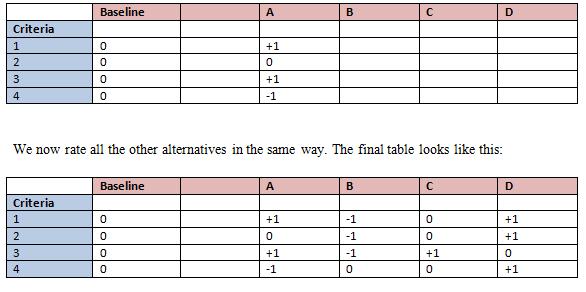The Pugh Analysis Matrix is an analysis tool that results in an optimal concept. You refine a list of ideas by using a matrix-based process to weight and compare the conceptual designs.
- Similar to pro vs cons
- Evaluate multiple options vs a baseline
- Use a matrix to address multiple factors.
The Pugh matrix was developed by Stuart Pugh who was the head of the design division and a Professor at the University of Strathclyde in Glasgow. This matrix has a variety of names some of which are the Pugh method, Pugh Analysis, the Decision Matrix Methods, matrix, decision grid, selection grid, selection matrix, problem matrix, problem selection matrix, problem selection grid, and solution matrix, criteria rating form, criteria-based matrix, opportunity analysis and many others like this.
This matrix when used for decision making, helps us select the best viable and most feasible option from a list of given alternatives. But to do this we need to first determine the most important criteria that we need in order to finalize our decision about the alternatives and then we select the best one based on this criterion. This method is mainly used by teams as well as individuals but it is better used by teams.
An interesting variation in team decision-making is for each individual to create his own pew matrix and then as a team the Pugh matrices are compared. Mostly, a Pugh matrix may be used to help evaluate a series of alternatives to make the best decision. It may also be used when only one solution is possible and you need to decide how to optimize it to make the best results. Or where multiple alternatives are available but none of them are good enough.
The Pugh Matrix can then be used to choose specific aspects of the all the alternatives and then combine them to make the most feasible product. The end product will be better than the product made initially.
How to Create a Pugh Analysis Matrix
Step 1: Create a chart of Criteria (y axis) vs Concepts (x axis)
Step 2: Pick one concept and rate it across all criteria.
Step 3: fill out the rest of the chart with a (Same, +, or -). This is done relative to the one we entered data for.
Step 4: Sum the + and – s. Come up with a net score. Ex. +4 or -1 or 0.
Step 5: Iterate across all concepts
Step 6: Merge the results to find the winner
Pugh Matrix Example
Let us assume that we have four alternatives A,B,C,D . We already have a system in place but we want to venture further and want to know if one of these four systems would be an improvement over the current system. We decide the criteria for the selection of alternatives. We then pick the four most important out of these and label them 1,2,3,4 (e.g. price, hours of work etc). Let’s draw the Pugh matrix now. We put all the alternatives at the top and then we assess all the alternatives with respect to the criteria which we keep on the left hand side as shown:

The baseline is the system that we have in place at the moment. Since we are going to compare and judge everything with respect to this therefore we rate it 0.
Now let us consider option A. When it comes to criteria 1, do we consider that it is better, the same as, or worse than the baseline? If it’s better we give it a +1, if it’s the same we give it a 0, and if it’s worse we give it a -1. Let’s say it’s +1. We then treat criteria 2, 3, and 4 in the same way. The table now looks like this:

Now that we have all the all the alternative scores, we can select the one which has the highest positive score which in this case happens to be D.
Weighting: Sometimes we can also give alternatives a weight i.e. the importance they have in a specific project and then using this weight we can determine the best option.
Pugh Matrix Videos
Six Sigma Black Belt Certification Pugh Analysis Questions:
Question: Which of the following tools is appropriate to use with multiple criteria requiring a single option to be selected? (Taken from ASQ sample Black Belt exam.)
(A) Pugh matrix
(B) Kano model
(C) Hypothesis testing
(D) PDCA
Answer:
A: Pugh matrix allows you to use multiple criteria to decide on the best option. The Kano model is about customer delight (or lack there of.) Hypothesis testing is a statistical validation (or not). PDCA stands for plan-do-check-act and is more of a framework for achieving great business results rather than a tool.
